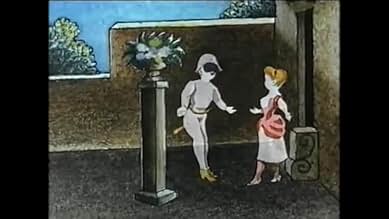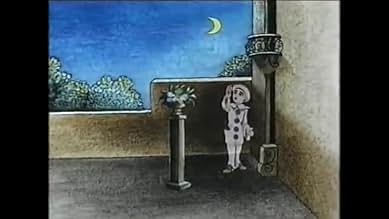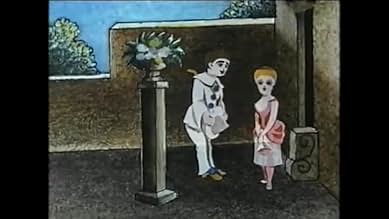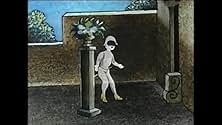AVALIAÇÃO DA IMDb
6,5/10
2,2 mil
SUA AVALIAÇÃO
Adicionar um enredo no seu idiomaOne night, Arlequin come to see his lover Colombine. But then Pierrot knocks at the door and Colombine and Arlequin hide. Pierrot starts singing but Arlequin scares him and the poor man goes... Ler tudoOne night, Arlequin come to see his lover Colombine. But then Pierrot knocks at the door and Colombine and Arlequin hide. Pierrot starts singing but Arlequin scares him and the poor man goes away.One night, Arlequin come to see his lover Colombine. But then Pierrot knocks at the door and Colombine and Arlequin hide. Pierrot starts singing but Arlequin scares him and the poor man goes away.
- Direção
- Roteirista
Avaliações em destaque
It is said that Pauvre Pierrot (1892) was the first animated film ever (it was presented with Le Clown et ses chiens (1892) and Un bon bock (1892)). Was exhibited in October 1892 when Charles-Émile Reynaud opened his Théâtre Optique at the Musée Grévin. It is probably the first usage of film perforations. Pauvre Pierrot originally consisted of 500 individually painted images, which originally was 15 minutes long, but the 1996 restoration made it 4 minutes long.
The story is about Harlequin (best-known of the zanni or comic servant characters from the Italian Commedia dell'arte), Colombina (a stock character in the Commedia dell'Arte, she is Harlequin's mistress, a comic servant playing the tricky slave type and wife of Pierrot) and Pierrot (is a stock character of pantomime and Commedia dell'Arte). It is a comedy, though nowadays it isn't that funny, in its time it must have been one of the funniest things that existed. I wish I was there when it happened.
The story is about Harlequin (best-known of the zanni or comic servant characters from the Italian Commedia dell'arte), Colombina (a stock character in the Commedia dell'Arte, she is Harlequin's mistress, a comic servant playing the tricky slave type and wife of Pierrot) and Pierrot (is a stock character of pantomime and Commedia dell'Arte). It is a comedy, though nowadays it isn't that funny, in its time it must have been one of the funniest things that existed. I wish I was there when it happened.
"Pauvre Pierrot" is apparently the first animated film and you probably want to read IMDB's trivia section on how the film was made. All I know is that the copy floating about YouTube is gorgeous and looks nothing like you'd expect a film that is 127 years old!
The story is very simple...something I'd expect from 1892 since films were just invented and complex stories were still not made for several years to come. The animation is very jerky (due to a low cel count) but speeding up the film could correct this...so if you find a copy and play it on Media Player Classic (for example), you can double the speed and it would look better.
As for the story, it's very, very simple and involves the classic Commedia dell'arte character, Pierrot, moving about on the screen with a girl. Not exactly thrilling today...but remember...it was 1892 and for that time, this is a really amazing piece of art.
The story is very simple...something I'd expect from 1892 since films were just invented and complex stories were still not made for several years to come. The animation is very jerky (due to a low cel count) but speeding up the film could correct this...so if you find a copy and play it on Media Player Classic (for example), you can double the speed and it would look better.
As for the story, it's very, very simple and involves the classic Commedia dell'arte character, Pierrot, moving about on the screen with a girl. Not exactly thrilling today...but remember...it was 1892 and for that time, this is a really amazing piece of art.
Cute and strange; oh, and it's the first animated thing put to film... ever. Impressive for that alone, AND it has a story! It may not be too deep, and may be a little confusing (what's with the guy that comes out of nowhere and steals the guy's ukulele or whatever it is, is he a ghost?) But it does have a beginning, middle and sort of an end, maybe, arguably. For what this french animator was able to accomplish - and did I mention in COLOR no less - and for the simple fact that this is one of the major accomplishments of that century, to get something with images moving, albeit jerkily, I say you should check out all four minutes on YouTube or wherever silent film shorts are sold.
History lesson time! Back when films were viewed as magical gimmicks rather than an art form, inventor Reynaud made advancements on the standard zoetrope that children would be hypnotised by, and patented the praxinoscope. The difference? The ability to give further dimensions to the strips that are used to project a flowing film. And that's where Pauvre Pierrot comes in (roughly translated as "Poor Pete"), part one of three short stories that combined to produce Reynaud's 'Pantomimes Lumineuses'. Whilst the other two are considered lost, this third has had four minutes restored from its original fifteen minute runtime. And much to my surprise, it's just as viewable now as it was back in 1892.
The straightforward plot consists of a man teasing another man to scare him away from a woman he was trying to woo. The limited fluidity resulted in the story being as clunky as various frame transitions (occasionally pausing on every third strip), but for such an experimental ancient silent film, the story isn't exactly at the forefront. It's the innovation, and Reynaud was an innovator through and through. Just by staring at the detailed drawings that are able to exude featured facial expressions, you get a sense of commitment from Reynaud. The lack of narrative interest is seemingly masked by the grandeur of this static backdrop, and it's still stupendously amazing to watch today. Will I remember it next week? Most likely not. However it's imperative to appreciate the milestones that paved the way for films today, and Pauvre Pierrot is a technical achievement.
The straightforward plot consists of a man teasing another man to scare him away from a woman he was trying to woo. The limited fluidity resulted in the story being as clunky as various frame transitions (occasionally pausing on every third strip), but for such an experimental ancient silent film, the story isn't exactly at the forefront. It's the innovation, and Reynaud was an innovator through and through. Just by staring at the detailed drawings that are able to exude featured facial expressions, you get a sense of commitment from Reynaud. The lack of narrative interest is seemingly masked by the grandeur of this static backdrop, and it's still stupendously amazing to watch today. Will I remember it next week? Most likely not. However it's imperative to appreciate the milestones that paved the way for films today, and Pauvre Pierrot is a technical achievement.
J. Stuart Blackton's 'Humorous Phases of Funny Faces (1906)' is generally held as the first animated film. Indeed, it was the first animated film made on motion-picture film, but such history is nevertheless unfair to Émile Reynaud, who, fourteen years earlier, was projecting moving animated images to delighted audiences. 'Pauvre Pierrot (1892)' is one of the director's few surviving works (most were, in a fit of frustration, discarded into the Seine by the director himself), and such a colourful and charming curio remains a delight to behold.
Reynaud animated each frame himself – 500 in total (36 metres long) – and extended the film to 12-15 minutes by personally manipulating the picture-bands during the projection. The story told is a simple one: Pierrot and Arlequin compete for the romantic attention of Colombine, a beautiful maiden. One potential suitor attempts to charm the good lady with a lute performance, but his competitor goes one better with a baton or sword of some sort.
Reynaud's moving picture show, billed as "Théâtre Optique" or "Pantomimes Lumineuses," included a triple-bill of three films: 'Pauvre Pierrot,' 'Un bon bock (1892),' and 'Le Clown et ses chiens (1892).' One contemporary newspaper reported that Reynaud "creates characters with expressions and movements so perfect that they give the complete illusion of life." The show was initially a great success, but, in 1918, Reynaud died a poor man. His delicate work, prone to rapid degradation, could not compete with the Lumière brothers' cinematograph, which depicted real-life, and not merely an animated approximation.
Reynaud animated each frame himself – 500 in total (36 metres long) – and extended the film to 12-15 minutes by personally manipulating the picture-bands during the projection. The story told is a simple one: Pierrot and Arlequin compete for the romantic attention of Colombine, a beautiful maiden. One potential suitor attempts to charm the good lady with a lute performance, but his competitor goes one better with a baton or sword of some sort.
Reynaud's moving picture show, billed as "Théâtre Optique" or "Pantomimes Lumineuses," included a triple-bill of three films: 'Pauvre Pierrot,' 'Un bon bock (1892),' and 'Le Clown et ses chiens (1892).' One contemporary newspaper reported that Reynaud "creates characters with expressions and movements so perfect that they give the complete illusion of life." The show was initially a great success, but, in 1918, Reynaud died a poor man. His delicate work, prone to rapid degradation, could not compete with the Lumière brothers' cinematograph, which depicted real-life, and not merely an animated approximation.
Você sabia?
- CuriosidadesThe cartoon was hand drawn on hundreds of sheets of glass, each inlaid in a leather strips, through which a light was shone projecting the figures on a backdrop, as it was spooled from one reel to another, much like a modern film reel.
- ConexõesFeatured in O Mundo Mágico de Georges Méliès (2002)
Principais escolhas
Faça login para avaliar e ver a lista de recomendações personalizadas
Detalhes
- Data de lançamento
- País de origem
- Idioma
- Também conhecido como
- Poor Pierrot
- Consulte mais créditos da empresa na IMDbPro
- Tempo de duração
- 5 min
- Mixagem de som
Contribua para esta página
Sugerir uma alteração ou adicionar conteúdo ausente






